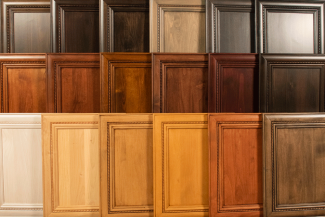

No, you cannot. The stain will not absorb due to the high moisture content of green wood and not accept the stain.
All bright white paint will yellow slightly with time, even without topcoat. You have probably tried to touch up white woodwork in your home after several years and noticed that the new paint is brighter.
But white and light paints can react if clear coated with a waterbased finish; water-based topcoats are reactive and may draw out substances in the wood such as tannins, dyes or unknown substances in existing finishes causing the topcoat to yellow. This is an industry-wide issue and can happen right away, years later or never.
General Finishes Water Based Stains have superior qualities over oil-based stains. Their high-quality pigments produce rich, dark, uniform colors on hard-to-stain woods like maple and pine.
Our recommendation to fix white cabinets that have yellowed is to do a thorough sanding and precleaning and recoat with the following products:
It is normal to see a bit of stain on the brush when applying the first coat of topcoat. Topcoats often pull a bit of color on the first pass, but good preparation will minimize this.
To prepare open grains woods such as raw Oak for a water-based stain, we recommend sanding with 180-grit followed by no more than 220-grit sandpaper.
GF advises extra care and prep when applying any finish over laminate surfaces because they are specifically designed not to mar and therefore they are not very "sand-able", making adherence difficult.
In addition to this non-permeable surface factor, General Finishes Gel Stain is an oil-based product, and it is more difficult to obtain proper drying characteristics over a dense manufactured surface such as laminate. Gel stains, as all wood stains, were formulated to go over raw wood which has an "open" surface and can absorb some of the stain.

As seen in Green Building and Design Magazine.
Water-based coatings are the future of finishing. You may not be using them today, but you will be in the next five years.

Now more than ever, water-based stains offer a viable alternative to oil-based and other solvent-based stains.
Water-based stains penetrate deeper into wood than oil-based stains, resulting in deep, rich colors in only one coat. Manufacturers, professionals, and DIY users moving away from solvent-based products to water-based systems find immediate advantages...